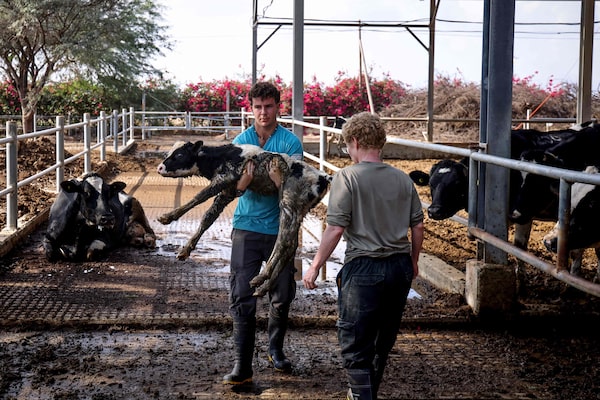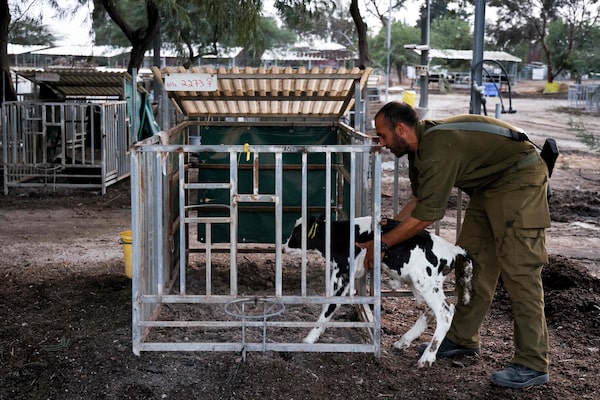
An Israeli volunteer carries a calf at a dairy farm in Nir Oz, one of the Israeli communities near the Gaza Strip attacked on Oct. 7 by Hamas.KENZO TRIBOUILLARD/AFP/Getty Images
It took Shlomo Margalit and the other founders of Kibbutz Nir Oz seven decades to nurture a parched corner of the Negev Desert into a lush oasis.
Hamas militants took a single morning to turn it into a charred wasteland.
“It was a kind of paradise,” Mr. Margalit, 86, said from a hotel in Eilat, where survivors of the Nir Oz massacre have been staying since the Oct. 7 attacks. “We plowed the land, lived on the land, built a just society. It was part of us. Now, imagine, everything you built with your 10 fingers over 70 years up in fire. Demolished. Looted. Smashed.”
The Hamas gunmen who poured across the Israeli border took a monstrous human toll, but they also targeted a singular form of settlement that holds a deeply symbolic place in the country’s history.
Militants ransacked at least 10 kibbutzim – co-operative communities originally established around socialist principles of communal ownership and equal distribution of wealth.
In Nir Oz, population 400, one in four residents was either killed or abducted that day.
As surviving residents grieve the dead and pray for a return of the missing, they also lament the loss of a home and way of life that may never return.
“If you ask me, I want to rebuild my life project,” Mr. Margalit said. “But first, we’re trying to recover from the shock. We’re still burying our friends.”
Some of those friends Mr. Margalit has known since 1955, when they arrived on the western edge of the Negev Desert as members of the Israeli army’s Nahal Brigade.
The Nahal Brigade trained soldiers while establishing farming communities that would reinforce the nascent state’s contested borders. When Mr. Margalit’s service in the brigade ended, he stayed put in the arid outpost, devoted to the idea of coaxing lush fields and a just society from the desert floor.
Conditions were grim. The community’s head landscaper, Ran Pauker, recalled in a recent journal article that just four trees stood on the property, which was characterized by “dust, heat and extreme radiation.”
What’s more, their Arab neighbours objected to the settlement from the start. “A lot of us stepped on mines,” Mr. Margalit said.
The kibbutzniks – residents of these settlements – imported drought-resistant plants from around the world, built irrigation systems, set up an education system, erected homes and other buildings.
In the early years, children would live and sleep apart from their parents. “We would study, sleep, shower, eat together, like a band of brothers if you will,” said Ziv Gome, who grew up in Nir Oz in the 1970s and 80s.
Israel-Hamas war: What to know about the attacks, casualties, hostages and the response
Bociurkiw: Netanyahu’s tough approach to Gaza may wipe out Hamas, but at what cost?

An Israeli soldier puts a calf in a feeding cage at a dairy farm in Nir Oz, on Nov. 14.KENZO TRIBOUILLARD/AFP/Getty Images
By then, there were about 110,000 people living on 255 kibbutzim across Israel. For decades, they formed the heartland of Israel’s dominant political left, said University of Victoria writing professor David Leach, author of Chasing Utopia: The Future of the Kibbutz in a Divided Israel. But their status shifted with the rise of the right-wing Likkud party in the 1970s.
“They explicitly targeted kibbutzniks as socialists sitting by swimming pools disconnected from the working-class religious Jewish Israelis,” he said. “The left has, over the years, been pushed further and further from political power.”
More recently, economic issues forced many kibbutzim to privatize. And many communal-living arrangements, such as the children-only houses, fell out of favour.
The most serious threat to Nir Oz’s future would arrive this year on Oct. 7, when waves of armed militants charged across the border wall that stands just three kilometres from Nir Oz. Mr. Gome wasn’t there, having moved to a different kibbutz. Countless childhood friends and family weren’t so lucky.
That morning, his twin sister, Renana Gome, received a call from sons Or, 16, and Yagil, 12. They were staying in Nir Oz with their father while she was elsewhere in the country. Scared and alone, they were hunkering down in the family mamad, or safe room, while air-raid sirens blared. She stayed with them on the phone as Hamas gunmen broke into the house.
She heard voices in Arabic. Just before the line went dead, she heard Yagil’s small voice, “I am too young. Don’t take me.”
Or and Yagil are now among the 40 children taken hostage during the massacre.
“I think of them, alone, in a pit or a dark tunnel with no sense of time,” Ms. Gome said in an animated re-enactment of the abduction posted to her Facebook page. “I hope they are together keeping each other strong.”
The family has received confirmation that the boys are alive.
Elsewhere in the kibbutz that day, militants reduced much of the community to a smouldering ruin – burning buildings, looting homes, killing around 30 residents.
At the home of Ruti and Avraham Munder, both 78, the militants took the couple hostage, along with their daughter, Karen Munder, and grandson, Ohad Munder-Zichri.
“These are people who participated in peace programs,” said Itay Raviv, a nephew of the couple. “My uncle and aunt used to take sick people from Gaza to Israeli hospitals for medical treatment.”
His cousin Ohad turned 9 as a hostage.
Nir Oz refugees have been burying their dead and pleading for the safe return of the hostages, who they feel have been neglected amid military operations in Gaza. When those tasks are complete, they will turn to the fate of Nir Oz. Currently, the area has effectively turned into a military outpost, Mr. Margalit said. A skeleton crew of people are permitted to water the fields and feed the livestock.
Recently, they erected a 13-metre-long Israeli flag on one side of a silo, the tallest structure around. Another side bears a flag of the Nir Oz logo and motto: “Not weary. Trailblazers.” Both would be clearly visible from Gaza.
In late October, a government official told residents that any reconstruction would take at least two years, according to a Haaretz report. Some displaced community members say they’ll never return.
Mr. Margalit, one of the founders, has other ideas.
“Will most people come back? I believe we will,” he said. “I’m optimistic. We will return. We will return.”
No custom component found for subtype: oovvuu-video